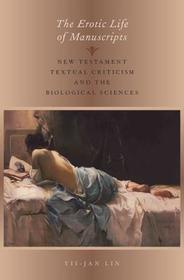
The Erotic Life of Manuscripts
New Testament Textual Criticism and the Biological Sciences
- Publisher's listprice GBP 97.00
-
46 341 Ft (44 135 Ft + 5% VAT)
The price is estimated because at the time of ordering we do not know what conversion rates will apply to HUF / product currency when the book arrives. In case HUF is weaker, the price increases slightly, in case HUF is stronger, the price goes lower slightly.
- Discount 10% (cc. 4 634 Ft off)
- Discounted price 41 708 Ft (39 722 Ft + 5% VAT)
Subcribe now and take benefit of a favourable price.
Subscribe
46 341 Ft

Availability
printed on demand
Why don't you give exact delivery time?
Delivery time is estimated on our previous experiences. We give estimations only, because we order from outside Hungary, and the delivery time mainly depends on how quickly the publisher supplies the book. Faster or slower deliveries both happen, but we do our best to supply as quickly as possible.
Product details:
- Publisher OUP USA
- Date of Publication 28 January 2016
- ISBN 9780190279806
- Binding Hardback
- No. of pages224 pages
- Size 236x157x22 mm
- Weight 431 g
- Language English
- Illustrations 1 illus. 0
Categories
Short description:
The Erotic Life of Manuscripts explores the curious relationship between the field of New Testament textual criticism and the biological sciences, beginning in the eighteenth century and extending into the present.
MoreLong description:
Since the New Testament's inception as written text, its manuscripts have been subject to all the dangers of history: scribal error, emendation, injury, and total destruction. The traditional goal of modern textual criticism has been to reconstruct an "original text" from surviving manuscripts, adjudicating among all the variant texts resulting from the slips, additions, and embellishments of scribal hand-copying. Because of the way manuscripts circulate and give rise to new copies, it can be said that they have an "erotic" life: they mate and breed, bear offspring, and generate families and descendants. The Erotic Life of Manuscripts explores this curious relationship between the field of New Testament textual criticism and the biological sciences, beginning in the eighteenth century and extending into the present.
New Testament textual critics who used language to group texts into families and genealogies were not pioneering new approaches, but rather borrowing the metaphors and methods of natural scientists. Texts began to be classified into "families, tribes, and nations," and later were racialized as "African" or "Asian," with distinguishable "textual physiognomies" and "textual complexions." These genealogies would later be traced to show the inheritance of "corruptions" and "contamination" through generations, an understanding of textual diversity reflective of eighteenth- and ninteenth-century European anxieties over racial corruption and degeneration.
While these biological metaphors have been powerful tools for textual critics, they also produce problematic understandings of textual "purity" and agency, with the use of scientific discourse artificially separating the work of textual criticism from literary interpretation. Yii-Jan Lin traces the use of metaphors and methods from the biological sciences by New Testament textual critics to show how the use of biological classification, genealogy, evolutionary theory, and phylogenetics has shaped--and limited--the goals of the field, the greatest of which is the establishment of an authoritative, original text. The conclusion of this study proposes new metaphors for the field.
With her research, Lin has provided a valuable service to New Testament textual criticism. With the benefit of this outside analysis, the hope is for an increased self-awareness within the discipline that seeks opportunities to shed any restraint imposed by the adopted biological metaphor and to leapfrog into new theories and methodologies of its own.
Table of Contents:
Acknowledgments
Introduction
Part I: Collection and Theorization
Chapter 1: Bengel and the Classification and Racializiation of Texts
Chapter 2: Lachmann and the Genealogy and Corruption of Texts
Part II: Historicization and Innovation
Chapter 3: Darwin, Streeter, and Narrative Textual Criticism
Chapter 4: Philology and Phylogeny
Conclusion
Appendix 1: Excerpt of Interview with Gerd Mink and Klaus Wachtel, Institut für Neutestamentliche Textforschung, Münster, March 10, 2011
Appendix 2: "Marcus Niebuhr Tod," by Maurice Bowra
Bibliography
Index


Performances of Ancient Jewish Letters: From Elephantine to MMT
64 013 HUF
57 612 HUF










